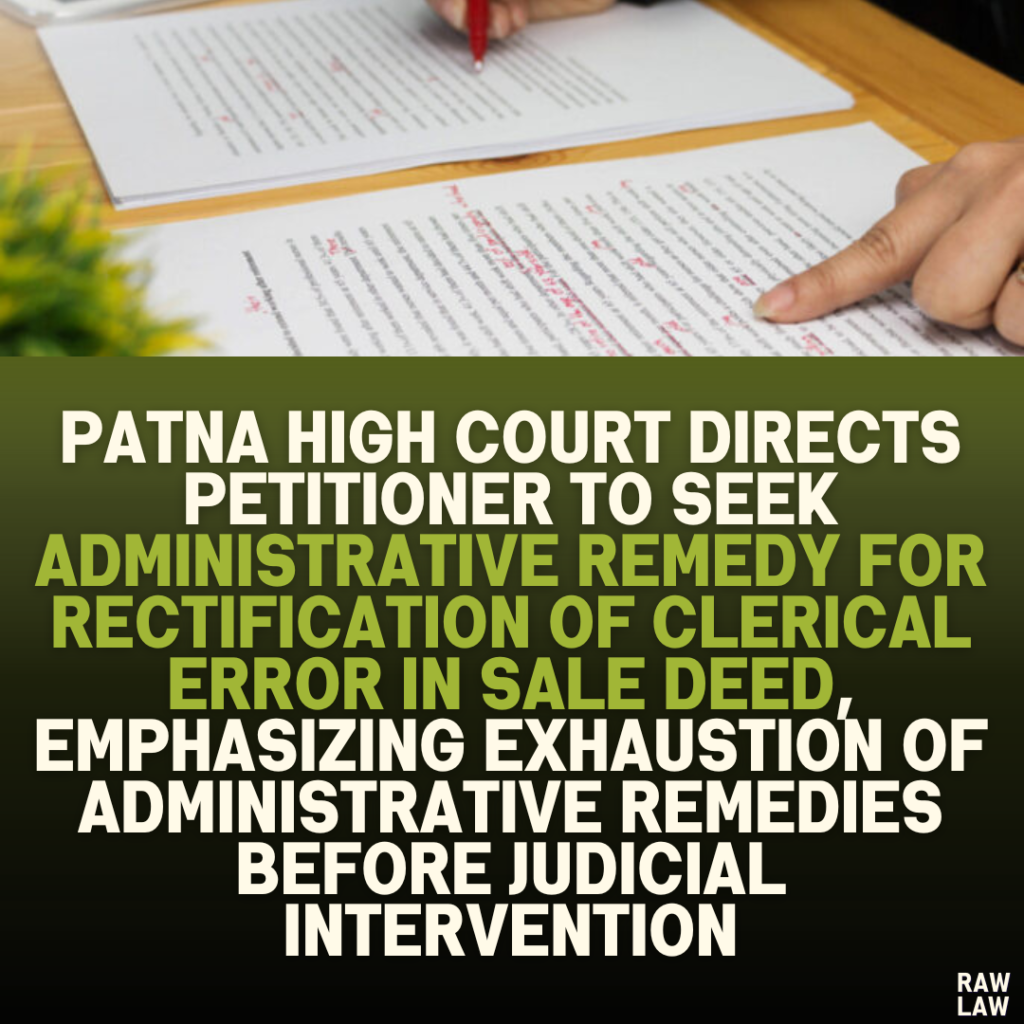Court’s Decision:
The Patna High Court disposed of the writ petition, emphasizing that the petitioner has the liberty to present their grievance before the competent authority. The court stated that the authority concerned must address the grievance regarding the rectification of the plot number in the registered sale deed.
Facts:
- The petitioner had purchased land and registered the sale deed on July 15, 2014.
- The plot number in the sale deed was erroneously mentioned as “1149” instead of the correct plot “1150.” This error was identified despite the sale deed accurately describing the boundaries of the plot as:
- North: Private seller,
- South: Radha Mohan Singh,
- East: Branch Road,
- West: Private seller.
- Based on this sale deed, Jamabandi No. 16093 was created, and other formalities such as mutation and tax payment were completed.
- The petitioner raised the issue that the error in the sale deed (plot number “1149” instead of “1150”) has caused administrative complications.
- Additionally, the petitioner alleged that the vendor (seller) had given oral assurances to rectify the mistake but failed to fulfill this commitment.
Issues:
- Whether the sale deed’s recorded plot number (“1149”) should be rectified to reflect the correct plot (“1150”)?
- Whether the petitioner should approach the competent authority for resolving the issue before seeking judicial relief?
Petitioner’s Arguments:
- The petitioner asserted that the plot number in the sale deed was incorrect and requested rectification.
- It was argued that the vendor had assured the petitioner that the mistake would be corrected, but no action was taken.
- The petitioner highlighted the accurate boundary description in the sale deed as evidence of the clerical error in the plot number.
- The petitioner sought directions from the court to order rectification of the sale deed and all connected official documents.
Respondent’s Arguments:
- The State’s counsel pointed out that the petitioner had not represented their grievance to any competent administrative authority before filing the writ petition.
- The counsel argued that the petitioner must first exhaust the available administrative remedies, and only then, if unsatisfied, approach the judiciary.
Analysis of the Law:
- The case primarily revolved around rectification of errors in registered documents such as sale deeds.
- Key Legal Principles Considered:
- The requirement for an aggrieved party to exhaust available administrative remedies before seeking judicial intervention.
- The role of the competent authority in rectifying such discrepancies under applicable land revenue and registration laws.
- The court noted that errors in registered sale deeds are administrative issues that should be resolved by relevant authorities before they are brought to court.
Precedent Analysis:
Although no specific cases were cited during the proceedings, the court’s decision aligns with the principles established in various judgments emphasizing:
- The hierarchy of dispute resolution, starting with administrative remedies.
- The judiciary’s limited role in cases where administrative procedures remain unexhausted.
Court’s Reasoning:
- The court found that the petitioner had not made any prior representation to the competent authority to resolve the issue.
- The court reasoned that competent administrative authorities, such as the Circle Officer or District Registrar, are equipped to handle such grievances and are the appropriate forums for the petitioner to approach first.
- It also highlighted that courts should not be the first recourse in matters that fall within the purview of administrative mechanisms.
Conclusion:
The court did not grant the relief sought directly. Instead, it disposed of the writ petition, granting the petitioner the liberty to approach the competent authority to rectify the error in the sale deed. The court clarified that the competent authority is required to examine the grievance and take appropriate action based on the evidence presented.
Implications:
- Administrative Emphasis: The judgment reaffirms the principle that disputes involving clerical or administrative errors in documents should first be resolved by relevant authorities.
- Judicial Restraint: It highlights the court’s role as a forum of last resort, underscoring that parties must exhaust all administrative remedies before filing petitions.
- Streamlining Dispute Resolution: The decision encourages the use of administrative forums to resolve technical issues, reducing unnecessary litigation and expediting resolutions.
This detailed explanation outlines the entire judgment process, breaking it down into each critical component to ensure clarity and comprehension. The implications demonstrate the broader significance of the ruling within the legal framework.




Pingback: Bombay High Court Rejects MCGM's Delay Plea in Land Compensation Appeals, Declines to Extend Statutory 120-Day Limit Under Section 74 of the 2013 Act - Raw Law